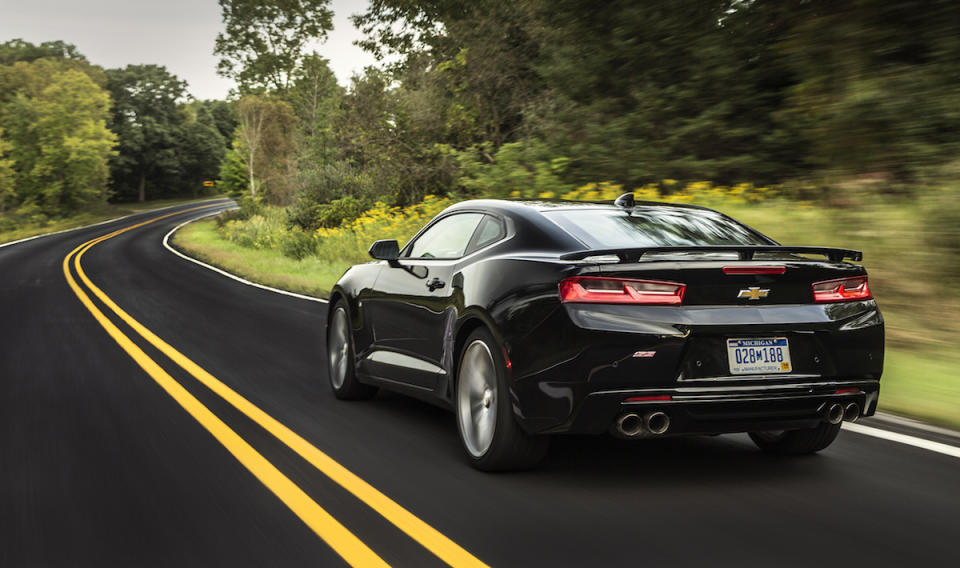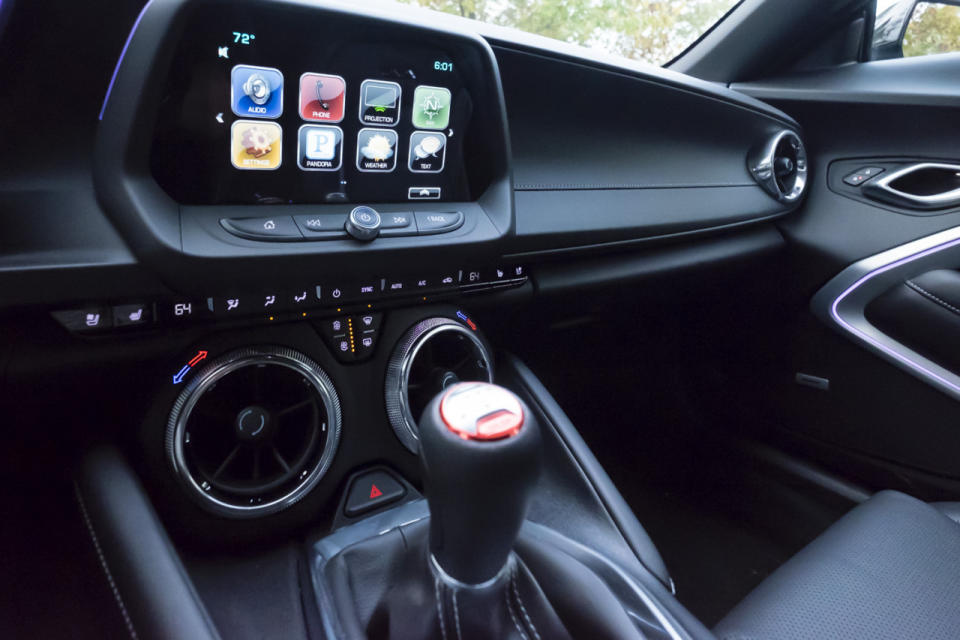2016 Chevrolet Camaro: First Drive
The sixth generation of Chevy’s iconic muscle car takes everything you love—or hate—about the Camaro and turns it up a notch.
What it is: 2016 Chevrolet Camaro, two-door sports car
Price as tested: $26,695 for the V-6; $37,295
Competitors: Ford Mustang, Dodge Challenger
Alternatives: Chevy SS, Chevy Corvette, Dodge Charger

There’s a good reason The Dead Milkmen’s about a “bitchin’ Camaro” is one of the punk standards our time. Like punks themselves, the Camaro has long stood out for its brazen commitment to individuality. It has always been about kicking ass and taking names.
The new 2016 Chevy Camaro is no different. It’s not nice. It’s not polite. And it definitely likes to growl, as we discovered in our first drive last month around scenic Hell, Mich.

While the changes may look small from the outside, the Camaro has an all-new chassis. Visually, the designers over at Chevrolet decided not to mess too much with a winning formula. The 2016 model retains that muscular, hunched over look from previous generations. The greenhouse is still achingly small; in fact the whole car is a bit tighter, shaving a few inches in every dimension.
Not to be outdone by the EcoBoost option in the Ford Mustang, the first factory turbocharged Camaro arrives with a 2-liter 4-cylinder base model, good for 275 hp and 295 lb-ft of torque. The 6-speed manual transmission version will get to 60 mph is 5.4 seconds, while the 8-speed automatic adds a tenth of a second.
The 3.6L V-6 engine now knocks out 335 hp and 284 lb-ft of torque, with only a slight speed bump over the turbo’s run to 60 mph, at 5.2 seconds in the manual, and 5.1 seconds with the automatic. But those are the supporting players to the real star, the 6.2-liter V-8 in the SS, now churning out 455 hp and an equal amount of torque. Sprint times are much faster with this bad boy: 4.3 seconds while rowing your own, and 4.0 seconds in the automatic.

Of course, straight-line fun isn’t everything. In order to get the Camaro around the turns quickly, Chevrolet went on a mission to shed some 200 lbs. with the new frame. The 2-liter turbo is lighter than the EcoBoost Mustang by 185 pounds, while the V-6 is lighter than the Mustang V-6 by 95 pounds. Bring in another American muscle car and the numbers get even more impressive. The Camaro V-6 and V-8 both come in at nearly 400 pounds lighter than the corresponding Dodge Challenger.
Chevrolet offered us limited time in the V-6 and V-8 Camaros, and on residential country roads to boot, so it’s difficult to say how the car handles when pushed to the limit. Having said that, the weight reduction is noticeable from the first stab on the throttle and the first turn into the twisties. The 6-speed manual transmission offers clean and crisp shifts, while the 8-speed auto, when using the paddle shifters, will let you bring it to the red line and eke out as much power as possible.
If you’re not ready to become a heel-toe hero, the manual can come equipped with a rev-matching feature. It may be a little confusing at first as the function is turned on and off by what looks like paddle shifters, but once activated the computer blips the throttle upon downshifting, making you a better driver than you probably deserve to be. Steering feel is right on the money, although I am always longing for a hydraulic setup.
The 6th generation Camaro also comes with different drive modes: Snow/Ice, Tour, Sport, and for the SS only, Track. These modes adjust the throttle tip in, auto shift map, and steering feel. You can even adjust the interior ambient lighting to one of 24 different colors. You know, if that’s your jam.
There are two reasons for throwing down the cash for the SS model. The first: 455 hp. The second helps get those horses around the track: Magnetic Ride Control. Previously only found in the track-ready Camaro ZL1, the technology is now being offered on the SS. This system is able to read the road and driving conditions up to 1,000 times a second, and can adjust the dampers settings accordingly. The result is a smoother ride over broken pavement and more confidence in the turns. Take a crest at speed and the system adjusts to keep you snugged down tightly to the road. Fly over rough pavement and nary a rumble shall disturb your behind.
Still, I wouldn’t call the Camaro a corner carver. While markedly improved from the fifth-generation’s dynamics, it’s still a 3,700-lb. machine; you’d need anti-gravity to make it as nimble as a roadster.

Sightlines inside have improved a bit from last year, but a driver unfamiliar with modern Camaros will still feel like they’re taking a bath in a basement with the lights off. The high shoulder line looks great from the outside, but hinders visibility from the inside. When in reverse, the requisite backup camera mitigates some stress; otherwise, the rear window is just a sliver of daylight.
The redesigned dash moves up a notch in quality, dominated by an 8-inch touchscreen with the Chevy MyLink infotainment system and Apple CarPlay or AndroidAuto. It’s fairly intuitive and easy to use with sharp graphics. An electronic parking brake is new this year, (forget any parking lot E-brake hooning you may want to do) but the payoff is re-positioned cup holders that allow for easier access to the stick shift. We’ll take that trade off.

And while there is plenty of high tech happening in the cabin, drivers still get an analog speedometer and tachometer. One nifty design trick is the integration of the heating and cooling controls on the rings surrounding the air vents themselves. By cutting out the buttons, designers were able to lower the dash, letting a little more space into the cabin.
The front seats are comfortable and there is plenty of headroom for anyone at six feet tall and under. The backseat? That’s another story. With the driver’s seat adjusted to my seating position, at five-foot-nine, I barely had any room for my feet, let alone my knees. It’s so bad the press kit doesn’t even give the head and leg room numbers for the rear seat. Expect to carry only your enemies in the back.
EPA fuel ratings have not been released, but we do know the 2-liter turbo to return 30 mpg on the highway. The V-6 and V-8 both have Active Fuel Management system, which will disengage two cylinders under light throttle applications, so we expect the larger engines to return somewhere in the low 20’s combined.
Full pricing has not been announced, but we do know the 1LT will start at $26,695 while the 1SS will set you back $37,295. That’s a bit more than the comparable 2015 Mustang, but a bit less than the 2015 Challenger R/T Plus Shaker with the 5.7-liter Hemi V-8 or Scat Pack with the 6.4-liter V-8.
All three now rank among the best pony cars ever turned out by Detroit. The Challenger hews to its classic design with the monster 707-hp Hellcat as an option, while the Mustang has finally embraced a modern suspension and even a fairly avant-garde flat-plane crank V-8 in the Shelby edition. The new Camaro balances that fine line of tradition and technology in truly bitchin’ fashion.

